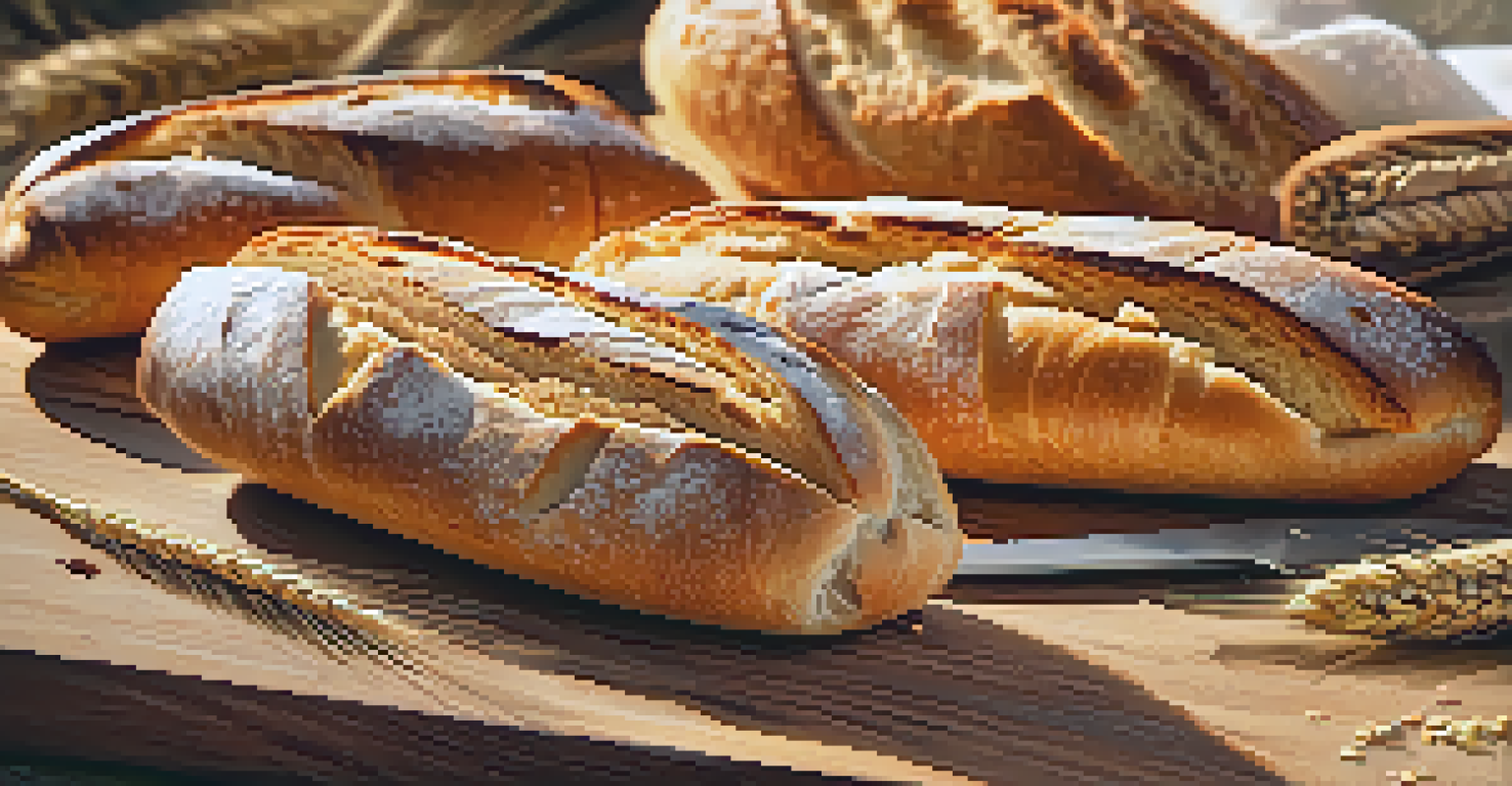Baguette Techniques: Crafting Perfect French Bread at Home

Understanding the Basics of Baguette Making
Before diving into baguette techniques, it's crucial to understand the basics of bread making. Baguettes are a staple in French cuisine, known for their crispy crust and soft, airy interior. The foundational ingredients include flour, water, yeast, and salt, each playing a vital role in the final product. Think of these ingredients as the main characters in a story—each one contributes to the delightful narrative of your baguette.
A loaf of bread, the finest gift of Earth, is a precious bread, full of life and flavor.
Flour is the star of the show, with bread flour being the preferred choice due to its higher protein content, which helps develop gluten. This gluten is what gives your baguette that lovely chewy texture. Water activates the yeast, making it essential for fermentation, while salt not only enhances flavor but also strengthens the dough. Understanding these components will set you on the right path to baking success.
As you start your baguette journey, remember that patience is key. Allowing your dough to rise properly is crucial for developing flavor and texture. Don’t rush it—great things take time, and your baguette will be all the better for it!
Choosing the Right Flour for Your Baguette
When it comes to baguette making, flour selection can significantly impact your results. French bakers typically use 'type 55' flour, which has a moderate protein content and gives a light, airy crumb. However, if you can't find this specific flour, bread flour is a great alternative that can yield excellent results. Think of flour as the foundation of a house; the sturdier the foundation, the better the house will stand.

Another option is to mix in a bit of whole wheat flour for added flavor and nutrition. Just be careful not to exceed 20% of your total flour weight with whole wheat, as too much can affect the bread’s texture. Experimenting with different flours can lead to delicious discoveries, so don’t hesitate to explore.
Essential Ingredients for Baguettes
Understanding the roles of flour, water, yeast, and salt is crucial for successful baguette making.
Ultimately, the right flour can make a world of difference in your baguette's flavor and texture. So, choose wisely, and remember that every baker has their own preferred blend that tells a unique story.
Mastering the Art of Dough Mixing and Kneading
Once you've chosen your flour, it's time to mix your dough. Start by combining the flour, water, yeast, and salt in a large bowl. The key is to incorporate the ingredients until they come together to form a shaggy dough. This initial mixing stage is like gathering a team before a big project—everyone needs to be on the same page for success.
Bread is the king of the table, and all else is merely the court that surrounds the king.
Kneading is where the magic really happens. By working the dough, you develop gluten, which gives your baguette structure. You can knead by hand for about 10 minutes or use a stand mixer with a dough hook for about 5 minutes. Just be careful not to over-knead, as this can lead to a dense loaf. Think of it as a workout; you want to build strength, but you don’t want to overdo it.
Once kneaded, let your dough rest and rise. This process is called fermentation, and it's essential for developing flavor and texture. After this stage, you'll be well on your way to crafting that perfect baguette!
The Importance of Proper Fermentation Techniques
Fermentation is a critical step in producing a flavorful baguette. This process occurs when yeast consumes sugars in the dough, releasing carbon dioxide and causing it to rise. A longer fermentation time can enhance the flavor profile of your bread, giving it that signature taste. It's like letting a good story marinate; the longer it sits, the richer it becomes.
For baguettes, a bulk fermentation period of at least 1-2 hours at room temperature is recommended, followed by a series of folds to strengthen the dough. You can also experiment with cold fermentation in the fridge for 12-24 hours. This method not only builds flavor but also makes the dough easier to shape later on.
Fermentation Enhances Flavor
Longer fermentation times allow the dough to develop richer flavors, elevating your baguette.
Understanding and mastering fermentation can elevate your baguette from good to extraordinary. So pay attention to this step, and watch as your dough transforms into something truly wonderful.
Shaping Your Baguette with Care and Precision
Shaping your baguette is where you can let your creativity shine. Once your dough has fermented, it's time to turn it into the classic baguette shape. Start by dividing your dough into equal pieces, usually around 250-300 grams each. Think of this process as sculpting; you’re taking a raw material and forming it into something beautiful.
Gently pre-shape each piece into a round, and let them rest for 15-20 minutes. This resting period allows the gluten to relax, making it easier to shape later on. When you’re ready, stretch and roll each piece into a long, slender loaf. The goal is to create a tight surface tension, which will help your baguette rise beautifully in the oven.
Remember that practice makes perfect. Don’t be discouraged if your first few attempts aren’t flawless. Each baguette you shape is a step towards mastering this essential skill.
Scoring: A Crucial Step for Baguette Perfection
Scoring your baguette before baking is an important step that should not be overlooked. This process involves making shallow cuts on the surface of the dough, which allows steam to escape during baking. Without scoring, your baguette may burst in unpredictable ways, leading to a less-than-perfect appearance. Think of scoring as giving your dough a voice; it helps it express itself during the baking process.
Using a sharp blade, also known as a lame, you can create decorative patterns or simple slashes. The cuts should be made at a slight angle to encourage the dough to expand properly. While it might seem like a small detail, it can make a significant difference in the final look and texture of your baguette.
Baking Requires Proper Techniques
Preheating the oven and creating steam are key steps to achieving a crispy crust and perfect texture.
So don’t skip this step! Scoring adds character to your baguette, making it not only delicious but visually appealing as well.
Baking Your Baguette to Perfection
Now comes the exciting part: baking your baguette! Preheat your oven to a high temperature, ideally around 475°F (245°C), and place a baking stone or a baking sheet inside to heat up. A hot surface is crucial for achieving that desirable crust. Think of your oven as the stage, and your baguette is the star performance; it needs the right environment to shine.
Before placing your baguette in the oven, introduce steam by adding water to a hot pan at the bottom of the oven. This steam helps create a crispy crust while maintaining moisture inside the bread. Bake your baguettes for about 20-25 minutes, or until they are golden brown and sound hollow when tapped on the bottom.

Once baked, let your baguettes cool on a wire rack. This cooling period allows the crust to stabilize and the inside to finish cooking. The aroma that fills your kitchen will be worth the wait, and your perfect baguette will be ready to enjoy!